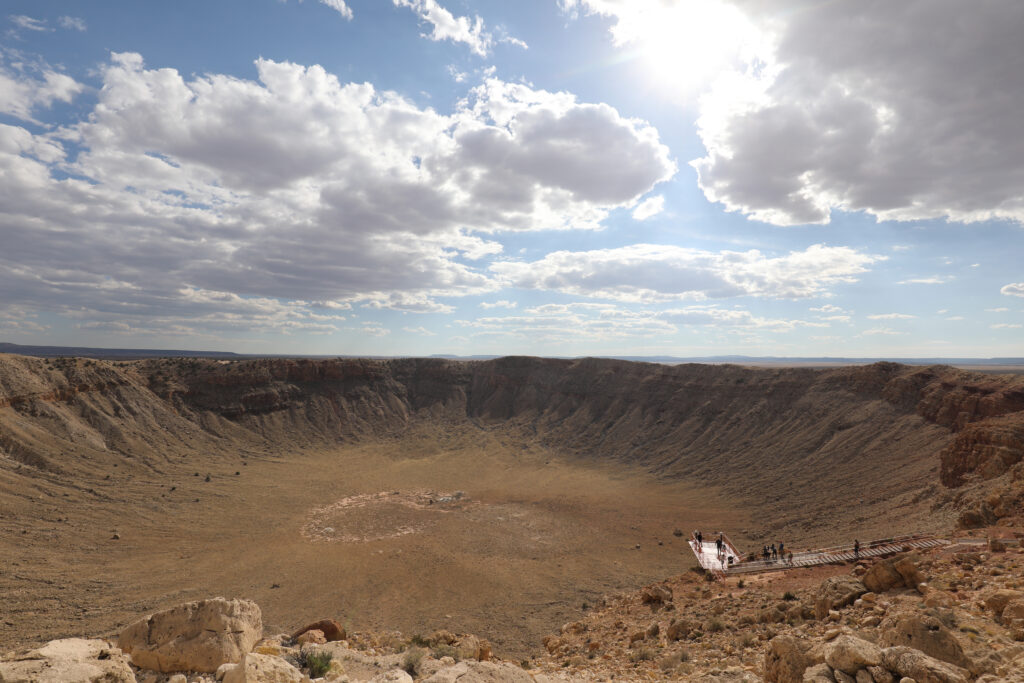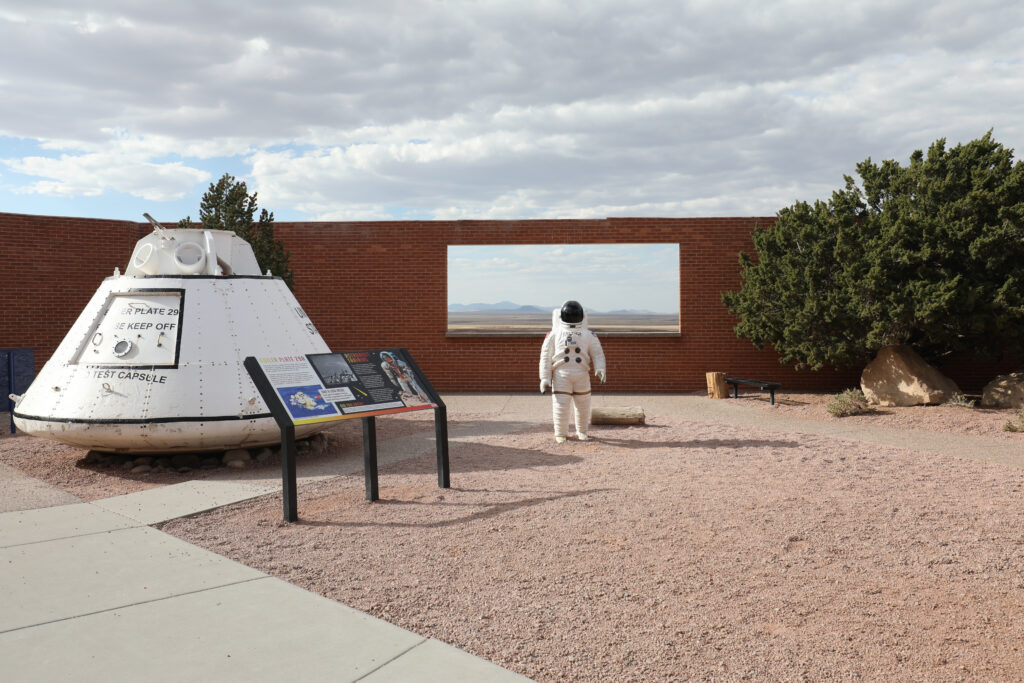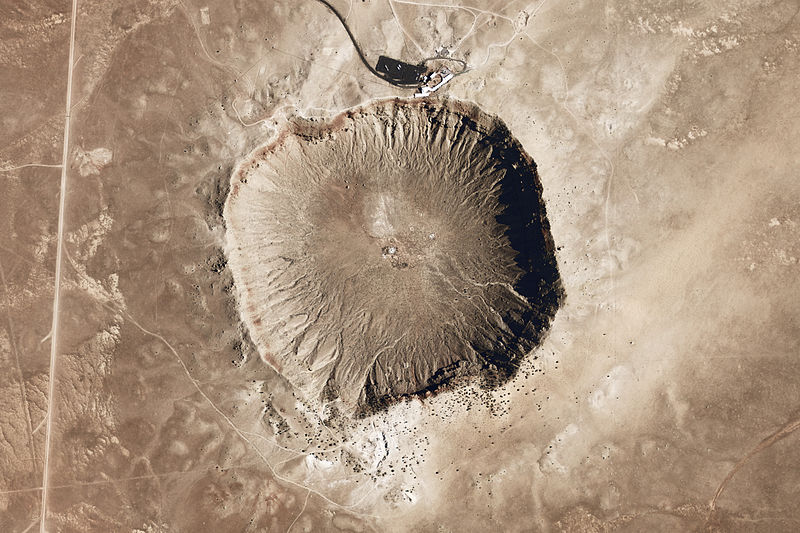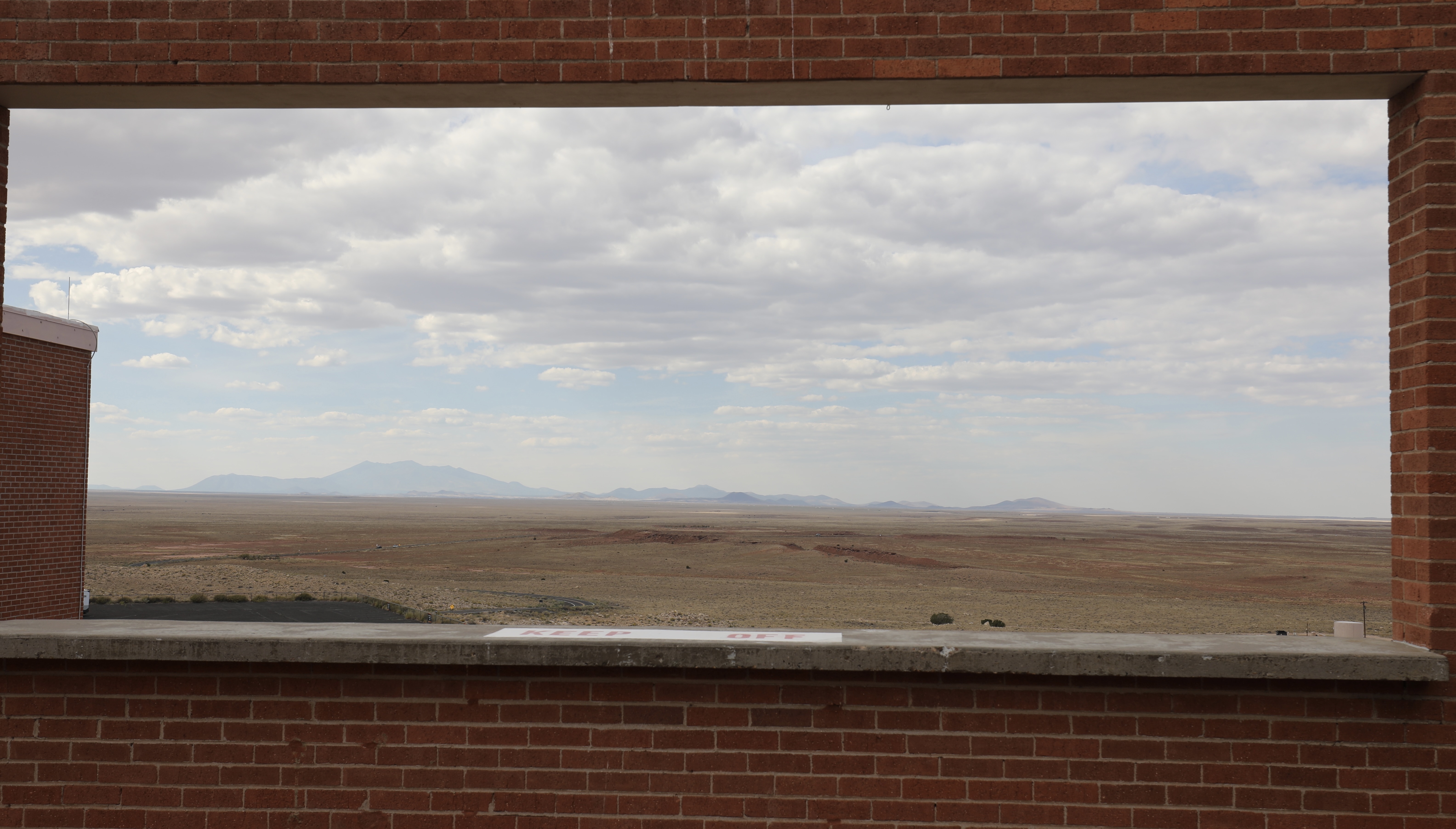Giant Meteor Crater, about a half mile in diameter and 700 feet deep, sits in the northern Arizona desert.


The giant crater off I-40 west of Winslow, Arizona, would have been an excellent National Monument. It is privately owned. The crater is fascinating, intriguing, and, let’s face it, a little concerning: so that’s what can happen! The interpretive center is not bad — the routine nine-minute orientation film, some meteor-related exhibits, and others commemorating the American Moon program — since some astronauts trained out here in the moonlike desert. As you enter the multi-story red brick museum complex, you are a little overwhelmed with “Worlds in Collision” music. What interpretation there is inside is competent and informative.
The catastrophic event occurred only yesterday — just 50,000 years ago. A meteorite — 150 feet across — (wouldn’t that be a meteor?) — slammed into northern Arizona (still not ready for statehood!) at 26,000 miles per hour — 7 miles per second. Of course, it knocked down whatever was in the vicinity, but this was desert then, too, and the population density was extremely low.
The crater is about half a mile in diameter. It looks like what a crater is supposed to look like — think of the moon — and it is extremely deep, more than 700 feet. Some of the sides are near enough to vertical that they experience occasional rock slides. In other areas there are gullies and rills with a very modest degree of desert vegetation. At the bottom is a large flat circle (manmade?) with some kind of pump at one end, an American flag precisely the size of Apollo 11’s, and a cheesy manikin of an astronaut standing tall.
It’s worth seeing despite the astronaut.
All this makes me think of the fragility of life. A hurricane in Florida shatters the lives of tens of thousands of human beings. Nearly 4 million people died in the China floods of 1931, and 2 million in 1887. All this is minor stuff from Jupiter: China lost only one percent of its citizens. The life force may be fragile on an individual scale, but so far, the species is in no immediate danger.
But imagine the mega catastrophes:
— Bretz’s Flood (the Missoula Floods) 15,000 years ago on the Columbia River;
— The Yucatan meteor strike 60 million years ago that bumped off the dinosaurs;
— The eruption of Mount Vesuvius in 79 CE (AD) near Naples, Italy. As many as 16,000 may have been killed and many hundreds were so quickly buried in ash that they were truly frozen in time, like a snapshot of everyone in the World Trade Center in all their activities an hour before the first attack.
They say the odds of a giant meteor striking Earth now are low — about the same as winning the lottery. To which I say, “Yeah, but someone does win the lottery.” It only takes once.

I walked out on the paved path to the highest rim of the crater. It is breathtaking to think of the energy that was more or less instantly expended in this place not so very long ago. The brochure says it was the equivalent of 20 million tons of TNT. (We had nuclear devices more than twice that powerful at one time, and probably still do). If this meteor(ite) was just 150 feet across and produced a half-mile crater 700 feet deep, imagine what the 5,000-foot meteor could do, or the 115,000-foot meteor.
I have been trying to be Mr. Affable out here. Last night, I had dinner in Bluff, Utah, with a complete stranger who happened to be in the RV slip next to mine. We had hours of good conversation, made easier (but not necessarily more productive) because we agreed on most public issues. (I did not manage to get his take on the Austrian philosopher Wittgenstein).
These days, I say hello to virtually everyone I meet on the road, and I make slightly ironic remarks from time to time.
Up at the observation station, I was minding my own business, trying to fathom the immensity of what had happened here, when a 30-something couple next to me (it was close quarters) started to hug. He said, “You’re cute.” She gave him a big, wet, loud smooch. Instantly, I turned on them, but so that the handful of others on the patio would know I was joking, and in a Felix Ungar voice, I said, “Hey, knock it off. No PDA here! This is the site of a crater.” A few people laughed (perhaps nervously) but the couple smiled broadly and said, “You’re welcome.”
So that was that. It reminds me of that Seinfeld episode where Jerry and his new girlfriend Sheila make everyone gag with their baby love talk. “Oh, Schmoopie.” “You’re Schmoopie!” “No, you’re Schmoopie.” “Oh, Schmoopie.” You may remember the Schmoopie business, but I had forgotten that it is a subplot of one of the handful of most famous Seinfeld episodes, The Soup Nazi.
In retrospect, I wish I had pointed to the crater and said, in full Okie, “Fill that puppy; you could have a real nice resort right here.” Which is amazing to imagine.

But then, on my way out, I ran into them again. We were all looking out on tens of thousands of acres of barren desert. A half-serious fence a hundred yards away and an abandoned hogan a mile across the nothing.
I wanted to assure them I wasn’t a parson or a nut.
“Where you from?”
“Indiana.”
“First time here.”
“Yep.”
And then, propelled by some evil genii of misrule, I said, “Look out there and imagine all of it ripe corn.”
They looked at me as if I might possibly be insane or an eccentric savant, but they nodded and offered a pro forma mini-laugh. Then, the Hoosiers got into their minivan and drove away. I hope I don’t wind up on some comment site.
Look, folks, I am still perfecting this. Give me a break.
I know it’s ghoulish and irresponsible, but I am particularly attracted to certain disasters — especially if they were long ago. I have fantasized about Glen Canyon Dam in 1983, where Lake Powell filled to the rim and hydro-engineers seriously wondered if they would lose the dam. Perhaps partly from a sizeable recent dose of Edward Abbey (including having a morning with one of his closest friends), I sometimes fantasize about the collapse of Glen Canyon Dam. Would it take out Hoover Dam? Would the lower Colorado carve out a bold new course, as it did early in the 20th century in a big water year? I would have given anything to have seen an atomic detonation in southern Nevada. People got special packages at Las Vegas Hotels during the above-ground tests that sometimes included the chance to meet Miss Atomic with her pillowy mushroom cloud sleeves. I’ve only been in one tiny earthquake, never within half a mile of a tornado.
I would not want to see the Challenger disaster or the Hindenburg, of course, or any other catastrophe with the immediate loss of humans. But I’ll watch a skyscraper implosion any Saturday of the year. I know it is odd, but I find a kind of poetry in a mushroom cloud that doesn’t intend to kill anyone.
Continuing to gaze into the crater at some point creates no additional pleasure, so I made my way to the exit. The gigantic gift shop sells precisely what you would expect — crater snow globes, magnets, patches, t-shirts, caps, pencils with your first name on them, gems, faux arrowheads, and playing cards with the crater on the back. A machine to turn a penny (for a quarter) into a commemorative medallion was out of order.
The store had six unrelated children’s books and exactly three books for adults. None interesting except to a very patient and forgiving geologist.
Now I’m back in my RV park, temperature 85, 4:30 pm. “It’s Miller Time!” However you define Miller.
